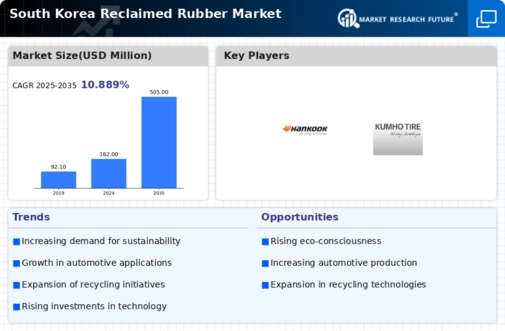The competitive landscape of the South Korea Reclaimed Rubber Market is shaped by several key players, each contributing to the dynamic and evolving nature of the industry. The market has exhibited notable growth driven by increasing awareness of sustainability, recycling practices, and the need for cost-efficient materials. As more industries recognize the economic and environmental benefits of reclaimed rubber, competition has intensified, leading companies to innovate and expand their product offerings.
The interplay of domestic demand and international trade also influences market dynamics, presenting both challenges and opportunities for local manufacturers. In this context, understanding the competitive insights of the market becomes crucial for stakeholders aiming to capitalize on growth trends and identify strategic partnerships or potential market entry points.
Seung Jin Rubber is a prominent player in the South Korean Reclaimed Rubber Market, recognized for its commitment to quality and innovation. The company leverages advanced manufacturing processes that yield high-performance reclaimed rubber products suitable for various applications, including automotive and industrial uses. Its strength lies in its ability to maintain robust partnerships with local suppliers, ensuring a steady supply of raw materials that meet stringent quality standards.
Seung Jin Rubber's focus on research and development allows it to remain responsive to evolving market needs, enabling the company to introduce new and improved formulations that cater specifically to the demands of South Korean industries. This agility, combined with a strong reputation built over years of operation, positions Seung Jin Rubber favorably within a competitive market landscape.
Shinhan Rubber also holds a significant position in the South Korea Reclaimed Rubber Market, marked by its extensive range of products and strong distribution channels. The company specializes in producing reclaimed rubber that is utilized in tire manufacturing, sealing materials, and various industrial products, aiming to provide eco-friendly alternatives while meeting consumer demand for durability and performance. Shinhan Rubber has invested in strategic mergers and acquisitions to bolster its market presence, enhancing its operational capabilities and expanding its product lines.
The company's strengths are evident in its continuous focus on innovation, customer relations, and sustainability practices, making it a preferred supplier in many sectors within South Korea. As the market moves towards greener practices, Shinhan Rubber's commitment to developing sustainable solutions positions it well for future growth and long-term success.













Leave a Comment